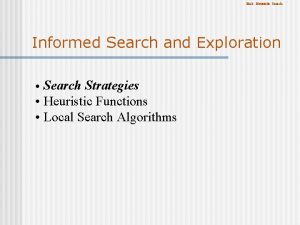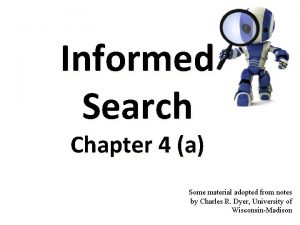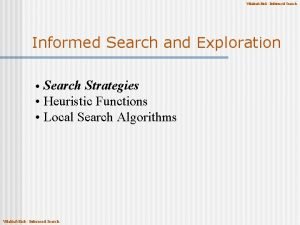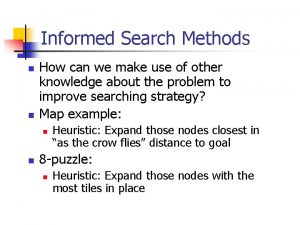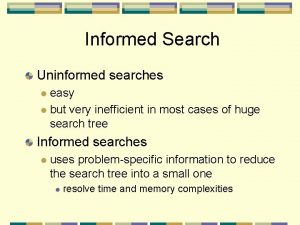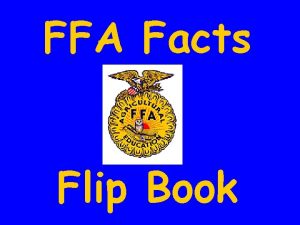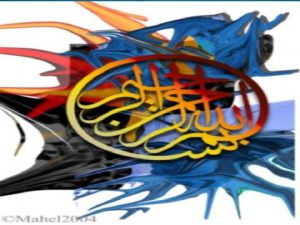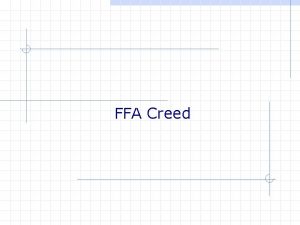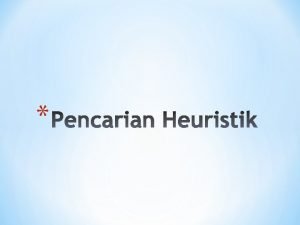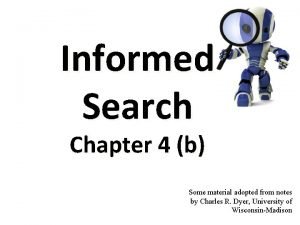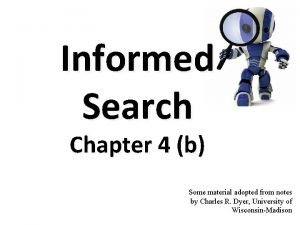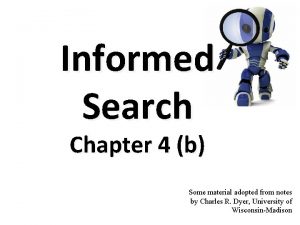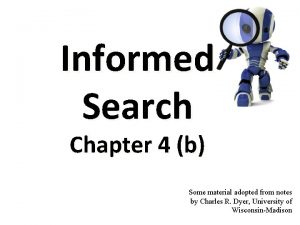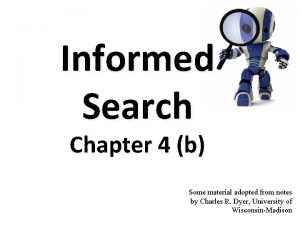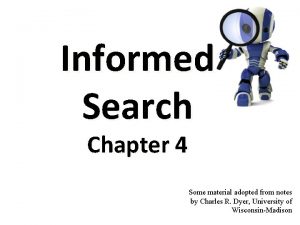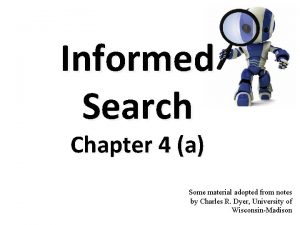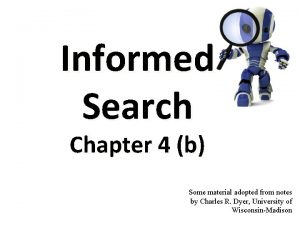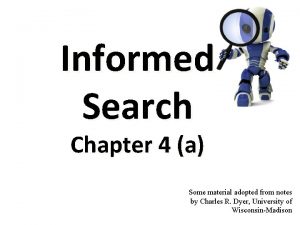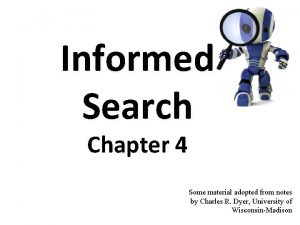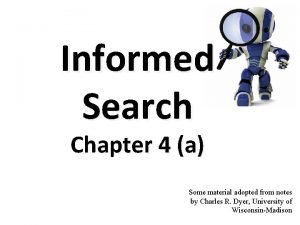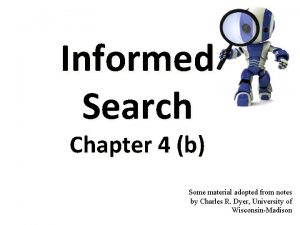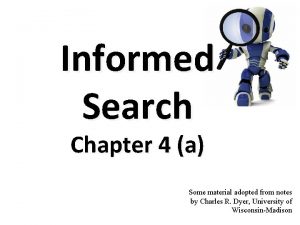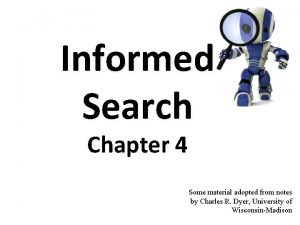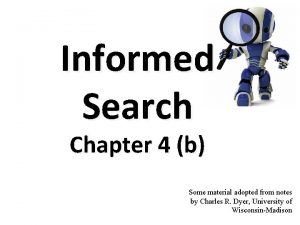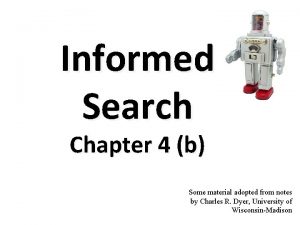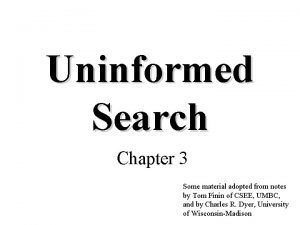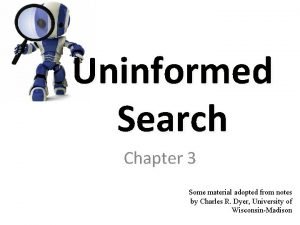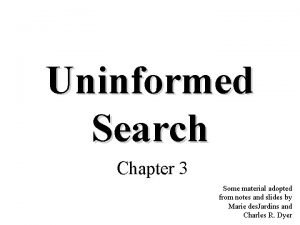Informed Search Chapter 4 Some material adopted from











































- Slides: 43

Informed Search Chapter 4 Some material adopted from notes by Charles R. Dyer, University of Wisconsin-Madison

Today’s class • Heuristic search • Best-first search – – Greedy search Beam search A, A* Examples • Memory-conserving variations of A* • Heuristic functions • Iterative improvement methods – – Hill climbing Simulated annealing Local beam search Genetic algorithms • Online search

Big idea: heuristic Merriam-Webster's Online Dictionary Heuristic (pron. hyu-’ris-tik): adj. [from Greek heuriskein to discover. ] involving or serving as an aid to learning, discovery, or problem-solving by experimental and especially trial-and-error methods The Free On-line Dictionary of Computing (15 Feb 98) heuristic 1. <programming> A rule of thumb, simplification or educated guess that reduces or limits the search for solutions in domains that are difficult and poorly understood. Unlike algorithms, heuristics do not guarantee feasible solutions and are often used with no theoretical guarantee. 2. <algorithm> approximation algorithm. From Word. Net (r) 1. 6 heuristic adj 1: (computer science) relating to or using a heuristic rule 2: of or relating to a general formulation that serves to guide investigation [ant: algorithmic] n : a commonsense rule (or set of rules) intended to increase the probability of solving some problem [syn: heuristic rule, heuristic program]

Informed methods add domain-specific information • Add domain-specific information to select the best path along which to continue searching • Define a heuristic function, h(n), that estimates the “goodness” of a node n. • Specifically, h(n) = estimated cost (or distance) of minimal cost path from n to a goal state. • The heuristic function is an estimate, based on domain-specific information that is computable from the current state description, of how close we are to a goal

Heuristics • All domain knowledge used in the search is encoded in the heuristic function, h(). • Heuristic search is an example of a “weak method” because of the limited way that domain-specific information is used to solve the problem. • Examples: – Missionaries and Cannibals: number of people on starting river bank – 8 -puzzle: number of tiles out of place – 8 -puzzle: sum of distances each tile is from its goal position • In general: – h(n) >= 0 for all nodes n – h(n) = 0 implies that n is a goal node – h(n) = ∞ implies that n is a dead-end that can never lead to a goal

Weak vs. strong methods • We use the term weak methods to refer to methods that are extremely general and not tailored to a specific situation. • Examples of weak methods include – Means-ends analysis is a strategy in which we try to represent the current situation and where we want to end up and then look for ways to shrink the differences between the two. – Space splitting is a strategy in which we try to list the possible solutions to a problem and then try to rule out classes of these possibilities. – Subgoaling means to split a large problem into several smaller ones that can be solved one at a time. • Called “weak” methods because they do not take advantage of more powerful domain-specific heuristics

Heuristics for 8 -puzzle Current State The number of misplaced tiles (not including the blank) 1 2 3 4 5 6 7 Goal State 1 4 7 8 2 5 8 3 6 In this case, only “ 8” is misplaced, so the heuristic function evaluates to 1. In other words, the heuristic is telling us, that it thinks a solution might be available in just 1 more move. 11 22 33 44 55 66 77 8 8 N N N N Y

Heuristics for 8 -puzzle Manhattan Distance (not including the blank) Current State Goal State 3 2 8 4 7 5 1 6 1 4 7 2 5 8 3 2 spaces 8 3 6 • In this case, only the “ 3”, “ 8” and “ 1” tiles are misplaced, by 2, 3, and 3 squares respectively, so the heuristic function evaluates to 8. • In other words, the heuristic is telling us, that it thinks a solution is available in just 8 more moves. • The misplaced heuristic’s value is 3. 3 3 spaces 8 1 3 spaces 1 Total 8

1 4 7 We can use heuristics to guide search. 1 4 7 In this hill climbing example, the Manhattan Distance heuristic helps us quickly find a solution to the 8 puzzle. goal 2 8 6 3 5 1 4 7 2 5 8 3 6 2 8 6 6 3 5 5 1 4 7 2 8 6 3 5 1 4 7 2 8 3 5 6 2 8 7 3 5 6 2 5 8 3 0 h(n) 4 1 6 1 4 7 4 1 4 7 2 8 3 5 6 1 2 4 8 3 5 6 7 2 5 8 3 6 3 2 2 3 1 4 7 2 8 3 5 6 3

1 4 6 In this example, hill climbing does not work! All the nodes on the fringe are taking a step “backwards” (local minima) Note that this puzzle is solvable in just 12 more steps. 1 2 3 4 6 5 8 7 2 5 7 7 1 4 2 6 7 3 8 h(n) 6 1 2 4 6 5 7 3 5 8 6 3 5 8 1 4 6 2 5 7 3 8 6

Best-first search • A search algorithm which optimizes depthfirst search by expanding the most promising node chosen according to some rule. • Order nodes on the nodes list by increasing value of an evaluation function, f(n), that incorporates domain-specific information in some way. • This is a generic way of referring to the class of informed methods.

Greedy best first search • Use as an evaluation function f(n) = h(n), sorting nodes by increasing values of f. • Selects node to expand believed to be closest (hence “greedy”) to a goal node h=2 (i. e. , select node with smallest f value) • Not complete h=1 • Not admissible, as in the example – Assuming all arc costs are one, then greedy search will find goal g, which has a solution cost of five – However, the optimal solution is the path to goal with cost three. a b h h=4 c i h=1 d h=1 e h=0 g 2

Beam search • Use an evaluation function f(n), but the maximum size of the nodes list is k, a fixed constant • Only keeps k best nodes as candidates for expansion, and throws the rest away • k is the “beam width” • More space efficient than greedy search, but may throw away a node that is on a solution path • As k increases, beam search approaches best first search • Not complete • Not admissible (optimal)

Algorithm A • Use as an evaluation function f(n) = g(n) + h(n) S 8 • g(n) = minimal-cost path from the 8 5 1 start state to state n 1 8 • g(n) term adds a “breadth-first” 5 B A C component to the evaluation function 9 7 3 5 • Ranks nodes on search frontier by 1 estimated cost of solution from start E 4 D G node through the given node to goal 9 • Not complete if h(n) can equal infinity • Not admissible (optimal) g(d)=4 C is chosen h(d)=9 next to expand

Algorithm A 1 Put the start node S on the nodes list, called OPEN 2 If OPEN is empty, exit with failure 3 Select node in OPEN with minimal f(n) and place on CLOSED 4 If n is a goal node, collect path back to start and stop 5 Expand n, generating all its successors and attach to them pointers back to n. For each successor n' of n 1 If n' is not already on OPEN or CLOSED • put n ' on OPEN • compute h(n'), g(n')=g(n)+ c(n, n'), f(n')=g(n')+h(n') 2 If n' is already on OPEN or CLOSED and if g(n') is lower for the new version of n', then: • Redirect pointers backward from n' along path yielding lower g(n'). • Put n' on OPEN.

Algorithm A* • • “A star” Described by Hart and Nilsson in 1968 Algorithm A with constraint that h(n) <= h*(n) = true cost of the minimal cost path from n to a goal h is admissible when h(n) <= h*(n) holds Using an admissible heuristic guarantees that the first solution found will be an optimal one A* is complete whenever the branching factor is finite, and every operator has a fixed positive cost A* is admissible Hart, P. E. ; Nilsson, N. J. ; Raphael, B. (1968). "A Formal Basis for the Heuristic Determination of Minimum Cost Paths". IEEE Transactions on Systems Science and Cybernetics SSC 4 4 (2): 100– 107.

Some observations on A • Perfect heuristic: If h(n) = h*(n) for all n, then only the nodes on the optimal solution path will be expanded. So, no extra work will be performed • Null heuristic: If h(n) = 0 for all n, then this is an admissible heuristic and A* acts like uniform-cost search • Better heuristic: If h 1(n) < h 2(n) <= h*(n) for all non-goal nodes, then h 2 is a better heuristic than h 1 – If A 1* uses h 1, and A 2* uses h 2, then every node expanded by A 2* is also expanded by A 1* – i. e. , A 1 expands at least as many nodes as A 2* – We say that A 2* is better informed than A 1* • The closer h is to h*, the fewer extra nodes that will be expanded

Example search space start state parent pointer 0 S 8 1 3 7 8 5 1 A 8 5 B 4 9 arc cost 4 4 D 8 E 9 G 0 8 C 3 5 h value goal state

Example n g(n) h(n) f(n) h*(n) S A B C D E G 8 8 4 3 inf 0 8 9 9 11 inf 9 9 9 4 5 inf 0 0 1 5 8 4 8 9 • h*(n) is the (hypothetical) perfect heuristic (an oracle) • Since h(n) <= h*(n) for all n, h is admissible (optimal) • Optimal path = S B G with cost 9

Greedy search f(n) = h(n) node expanded nodes list { S(8) } S { C(3) B(4) A(8) } C { G(0) B(4) A(8) } G { B(4) A(8) } • Solution path found is S C G, 3 nodes expanded. • See how fast the search is!! But it is NOT optimal.

A* search f(n) = g(n) + h(n) node exp. nodes list { S(8) } S { A(9) B(9) C(11) } A { B(9) G(10) C(11) D(inf) E(inf) } B { G(9) G(10) C(11) D(inf) E(inf) } G { C(11) D(inf) E(inf) } • Solution path found is S B G, 4 nodes expanded. . • Still pretty fast. And optimal, too.

Proof of the optimality of A* • Assume that A* has selected G 2, a goal state with a suboptimal solution, i. e. , g(G 2) > f* • We show that this is impossible – Choose a node n on the optimal path to G – Because h(n) is admissible, f* >= f(n) – If we choose G 2 instead of n for expansion, then f(n) >= f(G 2). – This implies f* >= f(G 2). – G 2 is a goal state: h(G 2) = 0, f(G 2) = g(G 2). – Therefore f* >= g(G 2) – Contradiction

Dealing with hard problems • For large problems, A* may require too much space • Two variations conserve memory: IDA* and SMA* • IDA* -- iterative deepening A* -- uses successive iteration with growing limits on f, e. g. – A* but don’t consider any node n where f(n) >10 – A* but don’t consider any node n where f(n) >20 – A* but don’t consider any node n where f(n) >30, . . . • SMA* -- Simplified Memory-Bounded A* – uses a queue of restricted size to limit memory use

On finding a a good heuristic • If h 1(n) < h 2(n) <= h*(n) for all n, h 2 is better than (dominates) h 1 • Relaxing the problem: remove constraints to create a (much) easier problem; use the solution cost for this problem as the heuristic function • Combining heuristics: take the max of several admissible heuristics: still have an admissible heuristic, and it’s better! • Use statistical estimates to compute g; may lose admissibility • Identify good features, then use a learning algorithm to find a heuristic function; also may lose admissibility

In-class Exercise: Creating Heuristics Missionaries and Cannibals 8 -Puzzle N-Queens Water Jug Problem 5 2 Remove 5 Sticks Route Planning

Iterative improvement search • Another approach to search involves starting with an initial guess at a solution and gradually improving it until it is one • Some examples: – Hill climbing – Simulated annealing – Local beam search – Genetic algorithms – Constraint satisfaction – Tabu search

Hill Climbing • Extended the current path with a successor node which is closer to the solution than the end of the current path • If our goal is to get to the top of a hill, then always take a step the leads you up • Simple hill climbing – take any upward step • Steepest ascent hill climbing – consider all possible steps, and take the one that goes up the most

Hill climbing on a surface of states Height Defined by Evaluation Function

Hill-climbing search • If there exists a successor s for the current state n such that – h(s) < h(n) – h(s) <= h(t) for all the successors t of n • • then move from n to s. Otherwise, halt at n Looks one step ahead to determine if a successor is better than the current state; if so, move to the best successor. Like Greedy search in that it uses h, but doesn’t allow backtracking or jumping to an alternative path since it doesn’t “remember” where it has been. Is Beam search with a beam width of 1 (i. e. , the maximum size of the nodes list is 1). Not complete since the search will terminate at "local minima, " "plateaus, " and "ridges. "

Hill climbing example start 2 8 3 1 6 4 7 5 -5 h = -4 -5 2 8 3 1 4 h = -3 7 6 5 -3 h = -3 goal 1 2 3 8 4 h=0 7 6 5 -2 1 2 3 8 4 h = -1 7 6 5 -4 2 3 1 8 4 7 6 5 2 3 1 8 4 h = -2 7 6 5 -4 f(n) = -(number of tiles out of place)

Exploring the Landscape • Local Maxima: peaks that aren’t the highest point in the space local maximum plateau • Plateaus: the space has a broad flat region that gives the search algorithm no direction (random walk) • Ridges: flat like a plateau, but with drop-offs to the sides; steps to the North, East, South and West may go down, but a step to the NW may go up. ridge Image from: http: //classes. yale. edu/fractals/CA/GA/Fitness. html

Drawbacks of hill climbing • Problems: local maxima, plateaus, ridges • Remedies: – Random restart: keep restarting the search from random locations until a goal is found. – Problem reformulation: reformulate the search space to eliminate these problematic features • Some problem spaces are great for hill climbing and others are terrible.

Example of a local optimum start 2 5 1 7 4 8 6 3 1 2 5 7 4 -4 8 6 3 -3 -4 1 2 5 8 7 4 -4 6 3 goal 1 2 3 8 4 0 7 6 5

Annealing • In metallurgy, annealing is a technique involving heating and controlled cooling of a material to increase the size of its crystals and reduce their defects • The heat causes the atoms to become unstuck from their initial positions (a local minimum of the internal energy) and wander randomly through states of higher energy. • The slow cooling gives them more chances of finding configurations with lower internal energy than the initial one.

Simulated annealing (SA) • SA exploits the analogy between how metal cools and freezes into a minimum-energy crystalline structure and the search for a minimum (or maximum) in a general system. • SA can avoid becoming trapped at local minima • SA uses a random search that accepts changes that increase objective function f, as well as some that decrease it • SA uses a control parameter T, which by analogy with the original application is known as the system “temperature” • T starts out high and gradually decreases toward 0

Simulated annealing • A “bad” move from A to B is accepted with a probability -(f(B)-f(A)/T) e • The higher the temperature, the more likely it is that a bad move can be made. • As T tends to zero, this probability tends to zero, and SA becomes more like hill climbing • If T is lowered slowly enough, SA is complete and admissible.

Simulated annealing algorithm

Local beam search • Basic idea – Begin with k random states – Generate all successors of these states – Keep the k best states generated by them • Provides a simple, efficient way to share some knowledge across a set of searches • Stochastic beam search is a variation on this – Probability of keeping a state is a function of its heuristic value

Genetic algorithms • Similar to stochastic beam search • Start with k random states (the initial population) • New states are generated by “mutating” a single state or “reproducing” (combining) two parent states (selected according to their fitness) • Encoding used for the “genome” of an individual strongly affects the behavior of the search • Genetic algorithms / genetic programming are a large and active area of research

Tabu search • Problem: Hill climbing can get stuck on local maxima • Solution: Maintain a list of k previously visited states, and prevent the search from revisiting them

CLASS EXERCISE • What would a local search approach to solving a Sudoku problem look like? 3 1 3 2

Online search • Interleave computation & action (search some, act some) • Exploration: Can’t infer outcomes of actions; must actually perform them to learn what will happen • Competitive ratio: Path cost found/ Path cost that would be found if the agent knew the nature of the space, and could use offline search * On average, or in an adversarial scenario (worst case) • Relatively easy if actions are reversible (ONLINE-DFSAGENT) • LRTA* (Learning Real-Time A*): Update h(s) (in state table) based on experience • More about these in chapters on Logic and Learning!

Summary: Informed search • Best-first search is general search where the minimum-cost nodes (according to some measure) are expanded first. • Greedy search uses minimal estimated cost h(n) to the goal state as measure; reduces search time, but is neither complete nor optimal. • A* search combines uniform-cost search and greedy search: f(n) = g(n) + h(n). A* handles state repetitions and h(n) never overestimates. – A* is complete and optimal, but space complexity is high. – The time complexity depends on the quality of the heuristic function. – IDA* and SMA* reduce the memory requirements of A*. • Hill-climbing algorithms keep only a single state in memory, but can get stuck on local optima. • Simulated annealing escapes local optima, and is complete and optimal given a “long enough” cooling schedule. • Genetic algorithms can search a large space by modeling biological evolution. • Online search algorithms are useful in state spaces with partial/no information.
 Informed search and uninformed search
Informed search and uninformed search Best first search in ai
Best first search in ai Informed (heuristic) search strategies
Informed (heuristic) search strategies Informed search example
Informed search example Uninformed search examples
Uninformed search examples What is the other name of informed search strategy?
What is the other name of informed search strategy? Image search
Image search Greedy search
Greedy search Informed and uninformed search
Informed and uninformed search Normal loss treatment in process costing
Normal loss treatment in process costing What is the ffa creed
What is the ffa creed Compras y vandalas system
Compras y vandalas system Unit cost meaning
Unit cost meaning Who wrote the ffa creed? when was it adopted?
Who wrote the ffa creed? when was it adopted? Ffa creed symbol
Ffa creed symbol Drug basket system
Drug basket system Curriculum development process in pakistan
Curriculum development process in pakistan Ffa creed facts
Ffa creed facts The institute of management accountants adopted the ______.
The institute of management accountants adopted the ______. Ffa creed assignment
Ffa creed assignment Meaning of unit costing
Meaning of unit costing Conventional representation of threads
Conventional representation of threads When was the ffa creed adopted and amended
When was the ffa creed adopted and amended Chapter 1 managerial accounting
Chapter 1 managerial accounting Sometimes you win some
Sometimes you win some They say sometimes you win some
They say sometimes you win some Cake countable or uncountable noun
Cake countable or uncountable noun Contact force
Contact force Some say the world will end in fire some say in ice
Some say the world will end in fire some say in ice Some say the world will end in fire some say in ice
Some say the world will end in fire some say in ice Some may trust in horses
Some may trust in horses Gd and t symbol
Gd and t symbol Standard costing and variance analysis formula
Standard costing and variance analysis formula Ethnocentrism examples
Ethnocentrism examples Whats cultural lag
Whats cultural lag Examples of non material culture
Examples of non material culture What are useful and harmful materials
What are useful and harmful materials Unified search vs federated search
Unified search vs federated search Local search vs global search
Local search vs global search Federated search vs distributed search
Federated search vs distributed search Httpstw
Httpstw Blind search dan heuristic search
Blind search dan heuristic search Gravity yahoo
Gravity yahoo Twvideos
Twvideos


